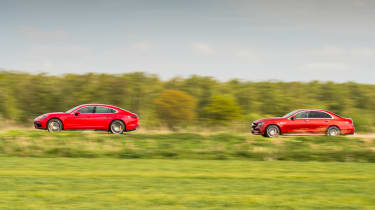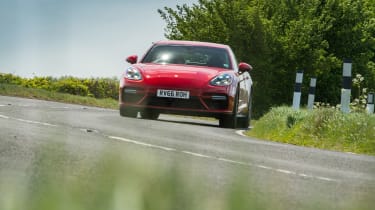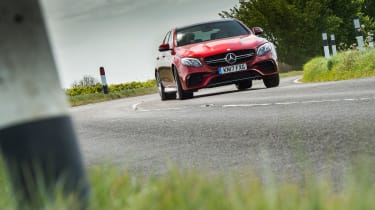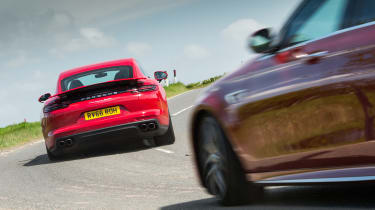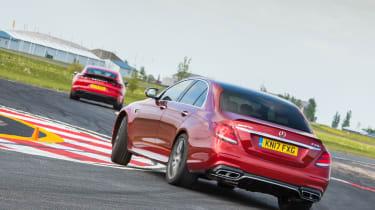Mercedes-AMG E63 S vs Porsche Panamera Turbo review – choose your executive weapon
The Mercedes E63 S has 603bhp and 627lb ft of torque at its disposal – but is this enough to overwhelm the mighty Porsche Panamera Turbo?
Nothing. Accelerating from a standstill to 60mph, not even the blink of an eye separates the fastest version of a bulky German saloon (one which, in a more basic spec, is popular with taxi companies around the world) and a Porsche 911 GT3 RS (991). At least by the reckoning of Porsche’s own figures for the GT3 and the data stream from our VBOX suckered to the windscreen of Mercedes-AMG’s E63 S. Like an apex athlete and a serial steroid abuser, they punch precisely the same hole in time and space, freezing the clock at 60mph with perfect synchronicity: 3.4sec. I’ll give you a moment for that to sink in. And another to acknowledge the presence of another Porsche, the Panamera Turbo. It sticks in a 3.4, too.
Of course, performance is about far more than a benchmark these days considered too paltry a gauge of a car’s true speed potential. So let’s move the goalposts: 0-100mph. The purist’s choice manual version of the GT3, after a perfectly judged start and two peachy gearshifts administered by an expert road tester or racing driver, logs a stunning 7.6sec, according to Porsche. Whoever’s driving the torque-drenched, twin-turbo taxi, no international racing licence required, has merely had to engage launch control, flatten the right-hand pedal, hang on and watch its stumpy bonnet draw ever so slightly ahead of the Porsche’s low-slung snout: 7.4sec. Were the race against a PDK-equipped GT3, it would be a dead heat. At this point, the Panamera has dropped back by nearly a second, and will continue slowly to lose ground into speed ranges we shouldn’t really talk about outside an autobahn service station. Even so, I reckon there are two stats to savour: the E63 S and Panamera Turbo accelerate from a standstill to 160mph in 19.4 and 22.2sec respectively. And that is simply mighty.
More reviews
In-depth reviews
Reviews
- Mercedes-Benz E55 AMG (W211, 2003 - 2006): review, specs and buying guide
- Mercedes-AMG E53 Hybrid 4Matic+ 2024 review – AMG’s first long-distance hybrid tested
- Mercedes E-class 2024 review – plug-in hybrid E300e tested
- Mercedes-AMG E53 2021 review – brimming with tech, but missing the charisma of an M550i
- Mercedes E-class 2020 review – new E450 a smooth operator
- New Mercedes-Benz E-class review
- Mercedes E400d AMG-Line estate review
That’s how far we’ve come. Welcome to the new performance paradigm for the well-heeled masses. Thing is, for all their all-weather, all-drive accelerative prowess, both cars face clear and present danger in their own burgeoning megasaloon arena, not just from electric slingshot Teslas but also the forthcoming ‘Hulk smash’ iteration of the BMW M5, which will also have twin-blower V8 horsepower and all-wheel drive. Something to look forward to. But for the here and now, this is a straightforward duel.
The old Panamera may have been controversially unlovely to look at but the Turbo S was extremely handy for something the size of a baby whale. The new, leaner Turbo S is now a hybrid with tech trickled down from the 918 Spyder, but the new regular Turbo you see here has better stats than the old S as well as the first implementation of the VW Group’s new MSB chassis and styling that more successfully realises the ‘upscaled 911’ intention of the original car. Its twin-turbo, 4-litre V8 develops 542bhp and 568lb ft of torque. Yet, on paper at least, the Porsche is, for once, comprehensively battered by its German neighbour. AMG’s idea of a 4-litre, twin-turbo V8 develops 603bhp and 627lb ft, and the E63’s 326bhp per ton power-to-weight ratio makes the heavier Panamera’s figure of 276 look a little pasty. This is reflected in the performance figures, of course, but it could be a different story on the road.
AMG’s long-lived E-class hot-rod rep, gloriously initiated by the 1991 300E Hammer, opens a new chapter here. It’s more than the big-engine, medium-sized car disconnect thing that’s fed the buzz for so long. Now there’s clever, too – specifically with the aim of making the E63 S more driver-focused and finessed than its predecessors. There’s a new wet-clutch nine-speed auto that shifts as swiftly as the Panamera’s eight-speed PDK for a start. And the four-wheel- drive system, with its electronically controlled rear diff, has been set up to provide a degree of rear-end mobility rather than lots of initial purchase that dissolves into understeer on the limit. There’s even a brave button – well, pull back on both steering-wheel paddles in one of the more extreme Dynamic Select settings, it’s the same thing – that disengages the front driveshafts and directs all 603bhp and 627lb ft to the rear wheels, intervention free. Drift Mode, big boy tempo.
The Panamera Turbo doesn’t have a drift mode but it does have Porsche Traction Management – an active all-wheel -drive system that seeks to balance both understeer and oversteer with the aim of delivering a nibble-around-neutral cornering balance rather than an entertainingly rear-biased one, which at least sounds like an efficient way to do business with big numbers.
First-gen Panameras weren’t perfect but I’ve always been a bit of a fan, and a recent trip to Porsche’s Nardò proving ground in southern Italy to sample the latest 671bhp Turbo S E-Hybrid (sadly, only from the passenger seat) could be said to have had a profoundly consolidating effect. Driving the plain Turbo to meet up with staff writer Will Beaumont, photographer Aston Parrott and the E63 S at designated showdown ground zero, it isn’t quite the shock and awe machine the S proved to be, but it nails the supersaloon basics with such crushing confidence and Porsche-infused charisma, I can’t help thinking that, for all its power, it’s the Merc that may be rocked and wobbled when the pair meet.
The new cabin has certainly helped reassert the appeal of the Panamera’s snug, low-slung architecture, the old confusing spray of centre-console buttons replaced by sleek, touch-sensitive surfaces and the analogue dials by a trio of crisp, clear digital displays. And it’s hard to think of another rear cabin space that feels quite as special, as in sync with the car’s dynamic demeanour. The deeply sculpted bucket seats are almost as comfortable and supportive as the ones up front. Not a new approach – I think the Lamborghini Espada got there first – but brilliantly executed nonetheless.
It’s obvious on the way to the rendezvous that the big Porsche has the compass to do smooth, supple and subtle as effortlessly as it does ballistic but, when the two cars test their mettle on the same roads, it’s clearer still that the Panamera never quite sheds a slightly buffered quality that smothers the edge of excitement. But if the supersaloon market thrives on contrast, that’s a good thing, because with the E63 S it’s exactly the opposite.
Before I acclimatise, the Merc feels comparatively tall and narrow after the Panamera and, despite being held tight by deeply contoured bucket seats every bit as good as the Porsche’s, no amount of high-tech bling, white upholstery or shiny dash trim can disguise the necessarily sensible, four-square, taxi-friendly E-class basics beneath. Naturally, 603bhp and 627lb ft have something to say on the first impressions front and, perhaps unsurprisingly, zap all that boring E-class stuff from immediate recall.
Taps open, the Merc is so relentlessly rampant it squeezes an involuntary chuckle from my upper respiratory system – the sort that commonly accompanies disbelief. I thought the 577bhp AMG GT R supercoupe I’d driven a week earlier was the quickest thing AMG made. Now I’m not so sure. The aural drama is tamped down here – a sort of soft-rock EQ as opposed to the GT R’s uncompressed thrash metal – but the heavy, vectored G-forces and wildly accelerated sensory frame-rate are just the same. It’s what genuine supercar performance feels like with an elevated view down the road, but without the underlying trepidation.
The steering’s surprisingly light, quick and pin-sharp. There isn’t much feel, but confidence builds as you start to lean on what seems an almost inexhaustible supply of front- end grip and explore just how much angle can be coaxed from the rear without decoupling drive to the front wheels altogether. More than you might think.
In the sportier Dynamic Select modes, the Merc’s suspension can feel drum-taut over broken surfaces. It’s the price you pay for zero-tolerance body control but, curiously, firm rarely becomes fidgety. Even the sharpest irregularities fail to fluster; they defer to a resolute underlying composure. As Will notes: ‘It feels alert, far more agile than you’d expect from a car this size, and feels very natural to drive quickly.’
Back in the Panamera Turbo, I get a contrastingly more pronounced elasto-kinematic feel, as if the chassis is having a somewhat convoluted, possibly argumentative, dialogue with the road surface. It’s a softer-edged dynamic that has some distinct lateral components, a mild shuffling of the hips, that nevertheless seems sufficiently well contained to keep the Panamera alert and responsive at speed and impressively glued to the tarmac. It’s a bit of an acquired taste and Will isn’t entirely convinced: ‘The steering doesn’t have the immediacy of the AMG’s, and there isn’t the same front- end grip. You have to be patient before the front tyres hook- up and you can get on the throttle. Once settled, you can use full-throttle, the rear tyres push the back around while the fronts try to pull you straight. They feel like they’re fighting against one another and trying to tear the tarmac up, but it works and it gains speed very quickly.’
It really does. Despite being down on power and torque (on paper) and still the size of a baby whale, the new Panamera refuses to be properly dropped by the E63 S at any point during the day, summoning reserves of surge from a secret stash Porsche always seems to build into anything with a ‘Turbo’ badge on its bootlid. It emerges from the encounter slightly bloodied but with its honour surprisingly intact. In the end, though, Will and I concur. For the time being at least, the E63 S is king of the supersaloons.
On Track
Will Beaumont
Each car retains its essential character on track, but traits are exaggerated and there’s a greater distinction between them. The Panamera feels direct and agile when you turn in aggressively, but beyond the first phase of a corner its softer chassis means it starts to feel heavy, almost cumbersome. Body roll absorbs much of your inputs, meaning it’s difficult to make fine corrections, and the front axle pushes on if you’re too eager with the throttle. Once you’ve found a flow, however, the Panamera exhibits that devastating point-to-point pace that it shows on the road.
The E63 feels more at home on track, astonishingly so for an almost- two-ton saloon. With sharp steering and the damping set to firm, it feels alert, while the bullish engine means there’s enough throttle adjustability even when it’s driving all four wheels. Its heft can’t be disguised completely, though; the exit of a corner can be tricky as you deal with a touch of weight transfer.
Activating Driift Mode and uncoupling the front driveshafts illustrates exactly why the E63 has four-wheel drive. It wants to oversteer everywhere and the transition is practically instant, though the long wheelbase means slides are easily held. Not the most effective way round a track, but hugely entertaining.
Specs
| Mercedes-AMG E63 S 4Matic+ | Porsche Panamera Turbo | |
| Engine | V8, 3982cc, twin-turbo | V8, 3996cc, twin-turbo |
| Power | 603bhp @ 5750-6500rpm | 542bhp @ 5750-6000rpm |
| Torque | 627lb ft @ 2500-4500rpm | 568lb ft @ 1960-4500rpm |
| Transmission | Nine-speed automatic,four-wheel drive, rear limited-slipdifferential, torque vectoring | Eight-speed dual-clutch,four-wheel drive, rear limited-slipdifferential, torque vectoring |
| Weight | 1880kg | 1995kg |
| Power-to-weight | 326bhp/ton | 276bhp/ton |
| 0-62mph | 3.4sec (claimed) | 3.6sec (claimed) |
| Top speed | 155mph (186mph option) | 190mph (claimed) |
| Basic price | £88,295 | £115,100 |
| evo rating (stars) | 5 | 4.5 |

